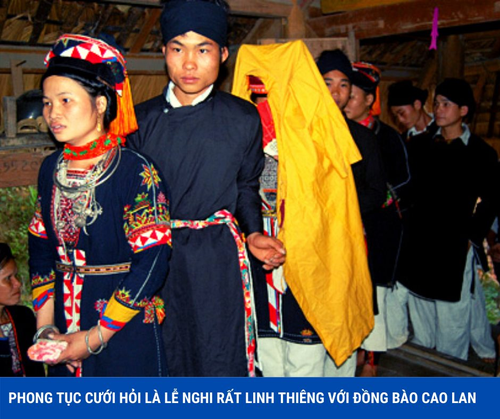 Wedding is a very important ceremony of the Cao Lan. (photo: phongtuc.vn) Wedding is a very important ceremony of the Cao Lan. (photo: phongtuc.vn) |
A Cao Lan wedding in the past was quite simple, but culturally distinctive. Artisan Luc Van Binh of Ba Che district said: “The family of the girl and the family of the boy asks for help from a matchmaker. In the past, it required that half a kilo of peanuts and 10 eggs be delivered to the bride's house. An uncle from each family is responsible. After delivering some betel nuts, the groom’s family asks the girl's family to put them in 2 bowls, one containing 4 betel leaves and one containing some money. Then the groom’s representative speaks politely to the bride’s representative about marrying the girl.”
If they agree to the marriage, the bride's family fills the two bowls. If not, they leave the two bowls as they were. Then the two families discuss the birth years of the bride and groom in order to choose a lucky wedding date.
“After the two families agree to become united by marriage, the wedding preparations continue. The girl’s family sets a date for the boy's family to come. An offering must be made of 72 Giay cakes and 3 capons to officially ask for permission to marry. After a lucky day has been chosen, the matchmaker goes to the bride’s house to set a date for the wedding ceremony.”
The marriage procedure of the Cao Lan people in Ba Che district today has been simplified to suit a modern lifestyle, but it preserves many traditional values
In the past a wedding ceremony continued for several days, but now it’s done in a single day.
Betrothal gifts depend on the financial situation of the groom's family. The bride's family does not burden them unduly.
On the wedding day, the groom's family sends a group of 7 to 9 people to bring the bride home. But the matchmaker and the people carrying the offerings cannot be there.
Artisan Luc Van Binh said: “On the wedding day, the groom gives the bride’s family all the necessary food to prepare a party the next day. The groom comes to the bride’s family home in the afternoon will spend one night there.”
In the past when the groom’s delegation came to the bride’s house, they all slept there one night. The groom was not allowed to go out of the house that whole night, even to go to the toilet. He had to eat dry food with ginger to avoid stomache trouble and drank very little water. Today, the two families can choose to follow the rule or not.
“In the past if the groom went outside on the first night, people would consider him a bad or clumsy person. The idea was to challenge the man’s patience on that first night. If he passed the test, he would be a faithful husband,” said Binh.
Before the bride leaves her room to follow the groom to his house, the matchmaker performs a ritual in her room to mark her new life. After that her bed is no longer hers.
At the groom’s house, the matchmaker performs a ritual to officially recognize the couple as husband and wife. The groom’s family prepares a small offering, including 2 bowls of food, two pairs of chopsticks, and a bottle of wine.
“The ritual casts a charm on the husband and wife. The matchmaker takes chopsticks in his left hand to pick up food for the wife and in his right hand to pick up food for the husband. They drink some wine,” said Binh.
Three days after the wedding, the Cao Lan couple visit the wife’s family with a groomsman. The wife’s family prepares a meal and invites relatives and villagers to take part:
He described: “Young people come and sing call-and-response songs all night. The next day, the couple returns to the groom’s house with a bridesmaid. They have a party and people sing through the night. Many people meet their future husband or wife at a call-and-response singing session like that.”